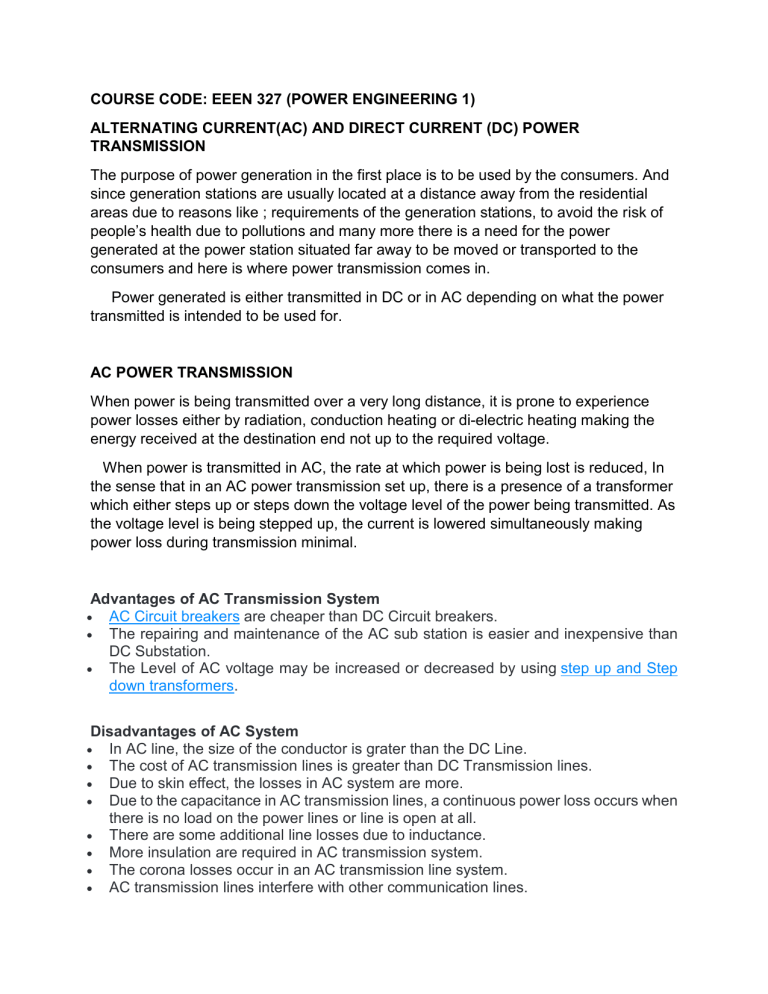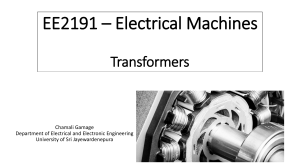
COURSE CODE: EEEN 327 (POWER ENGINEERING 1) ALTERNATING CURRENT(AC) AND DIRECT CURRENT (DC) POWER TRANSMISSION The purpose of power generation in the first place is to be used by the consumers. And since generation stations are usually located at a distance away from the residential areas due to reasons like ; requirements of the generation stations, to avoid the risk of people’s health due to pollutions and many more there is a need for the power generated at the power station situated far away to be moved or transported to the consumers and here is where power transmission comes in. Power generated is either transmitted in DC or in AC depending on what the power transmitted is intended to be used for. AC POWER TRANSMISSION When power is being transmitted over a very long distance, it is prone to experience power losses either by radiation, conduction heating or di-electric heating making the energy received at the destination end not up to the required voltage. When power is transmitted in AC, the rate at which power is being lost is reduced, In the sense that in an AC power transmission set up, there is a presence of a transformer which either steps up or steps down the voltage level of the power being transmitted. As the voltage level is being stepped up, the current is lowered simultaneously making power loss during transmission minimal. Advantages of AC Transmission System AC Circuit breakers are cheaper than DC Circuit breakers. The repairing and maintenance of the AC sub station is easier and inexpensive than DC Substation. The Level of AC voltage may be increased or decreased by using step up and Step down transformers. Disadvantages of AC System In AC line, the size of the conductor is grater than the DC Line. The cost of AC transmission lines is greater than DC Transmission lines. Due to skin effect, the losses in AC system are more. Due to the capacitance in AC transmission lines, a continuous power loss occurs when there is no load on the power lines or line is open at all. There are some additional line losses due to inductance. More insulation are required in AC transmission system. The corona losses occur in an AC transmission line system. AC transmission lines interfere with other communication lines. There are stability and synchronizing problems in AC System. AC transmission system is less efficient than the DC transmission System. There are difficulties in controlling the reactive power. WHY DC IS USED FOR TRANSMISSION It is asynchronous. That is, because DC has no frequency, it can be used to connect two different systems without worrying about having to synchronize the systems. The DC connection is a open circuit to AC systems. This is important when it comes to system stability-having that isolation helps to separate two separate systems in the event of a electrical fault event, such as lightning or equipment failure. The DC circuit limits the fault's path, essentially protecting the unfaulted part of the system it is connected to. For long distances, it is more economical. DC transmission towers take up less space which means less land can be used for right of way. Since DC only needs two poles at a maximum (sometimes one pole is used, and the ground is used as a return), less wire is needed. Towers are also more economical since they don’t have to carry three separate wires. Fewer losses. With a DC system, there are fewer losses--there is no reactive component to a DC circuit, so AC system- related losses like capacitive, inductive and skin effect are nonexistent. Again because there is no AC, losses and other issues associated with electrical coupling/induced currents are not an issue. There are only resistive losses as opposed to AC, which has reactive and resistive losses. Easy to transfer large blocks of power. With DC, direction of power can be switched easier. This makes DC indispensable for areas where summer loadings and winter loadings are opposite-for example a state that is cooler in winter in one area and warmer in summer in another area. The DC circuit could be used to export power to the colder region in the winter from the warmer region, and from the cooler region to the warmer region in summer. In Advantages of DC Transmission There are two conductors are used in DC transmission while three conductors are required in AC transmission. There are no inductance and surges (High Voltage waves for very short time) in DC transmission. Due to the absence of inductance, there are very low voltage drop in DC transmission lines as compare to the AC (if both Load and Sending end Voltage is same) There is no concept of Skin effect in DC transmission lines. Therefore, conductor having small cross sectional area is required in DC transmission line. A DC System has a less potential stress over AC system for same Voltage level. Therefore, a DC line requires less insulation. In DC System, there is no interference with other communication lines and systems. In DC Line, Corona losses are very low as compared to the AC transmission lines. In High Voltage DC (HVDC) Transmission lines, there are no dielectric losses. In DC Transmission system, there are no difficulties in synchronizing and related stability problems. DC system is more efficient than AC, therefore, the rate of price of Towers, Poles, Insulators, and conductor are low so the system is economical. In DC System, the speed control range is greater than AC System. There is low insulation needed in the DC system (about 70%). The price of DC cables is low (due to low insulation). In DC Supply System, the Sheath losses in underground cables are low. DC system is suitable for High Power Transmission based on High Current transmission. In DC System, The Value of charging current is quite low, therefore, the length of the DC Transmission lines is greater than AC lines. Disadvantages of DC Transmission: Due to commutation problem, electric power can’t be produced at High (DC) Voltage. In High Voltage transmission, we cant step-up the level of DC Voltage (As Transformer won’t work on DC). There is a limitation of DC switches and circuit breakers (and they are costly too). The motor generator set is used to step down the level of DC voltage and the efficiency of Motor-generator set is lower than a transformer. DC transmission system is more complex and costly as compared to the AC transmission system.. The level of DC Voltage can not be changed (step-up or step-down) easily. So we can not get desire voltage for electrical and electronics appliances (such as 5 Volts, 9 Volts 15 Volts, 20 and 22 Volts etc) directly from the transmission and distribution lines. CONCLUSION The above comparison shows that DC transmission system is better than the AC transmission system but still, the majority of power transmission is done in AC power lines due to cost and uses of transformers for changing the level of voltages at different levels for different purposes. Although, mercury arc rectifier, thyratron, diodes and semiconductors can be used to easily convert AC into DC and DC into AC. Therefore, some countries transmit the electric power through DC power lines. The range of these DC power transmission is up to 100kV to 800kV+. NAME: ADEPPOJU YUSUF ADEDIRAN REG NO: U18EE1110 DEPARTMENT: ELECTRICAL ENGINEERING





